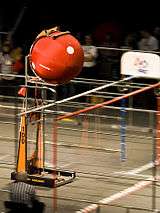FIRST Lego League
|
Current season, competition or edition: | |
 | |
| Sport | Robotics-related games |
|---|---|
| Founded | 1998 |
| Founder | Dean Kamen |
| President | Don Bossi |
| No. of teams | 29,873 (2016-2017) |
| Countries | International |
| TV partner(s) | NASA TV |
| Related competitions |
FIRST Robotics Competition FIRST Tech Challenge FIRST Lego League Jr. |
| Official website |
www |
FIRST LEGO League (FLL) is an international competition[1] organized by FIRST for elementary and middle school students (ages 9–14 in the United States and Canada, 9–16 elsewhere).[1]
Each year in August,[2] FIRST LEGO League introduces a scientific and real-world challenge for teams to focus and research on.[3] The robotics part of the competition involves designing and programming LEGO Mindstorms robots to complete tasks. The students work out solutions to the various problems they are given and then meet for regional tournaments to share their knowledge, compare ideas, and display their robots.
FIRST LEGO League is a partnership between FIRST and the LEGO Group. It also has a scaled-down robotics program for children ages 6–9 called FIRST Lego League Jr.
Competition details
At the beginning of the competition season, FIRST LEGO League sends official materials to each registered team, consisting of a 'challenge mat', LEGO bricks, and instructions for building the items for the mat (collectively known as the Challenge Set, formerly the Field Setup Kit). The teams also receive a list of tasks, called 'missions', to complete involving each model on the mat (i.e. taking a loose piece from one model and placing it inside another). FIRST LEGO League gives teams complete freedom on how to complete the missions, providing that they are completed by a programmed LEGO Mindstorms robot with no outside assistance. The robot has two and a half minutes to complete the missions. Each team has a minimum build period of 8 weeks to analyze the challenge mat, design and build a LEGO Mindstorms robot, and program it to fulfill the given missions in any manner they see fit. The robot must be autonomous,[4] and may contain only one LEGO Mindstorms programmable block and no more than 4 motors.
In addition to the live robot run, the competition has three additional judged sections with the purpose of providing teams with feedback on their achievement of the FIRST LEGO League learning objectives. The first judging session, Core Values,[2] is designed to determine how the team works together and uses the FIRST LEGO League Core Values in everything they do, which include inspiration, teamwork, Gracious Professionalism, and Coopertition. In most regions, teams are also asked to perform a teamwork activity (usually timed). Secondly, in the Robot Design, or technical judging,[2] the team demonstrates the mechanical design, programming, and strategy/innovation of their robot. Thirdly, in the Project,[2] the students must give a 5-minute presentation on research a topic related to the current challenge. The required steps of the project as teams to first identify a problem that is related to the topic of that year's competition, then create an innovative solution to their identified problem by modifying something that already exists or creating something completely new (an "innovative solution"), and then they must share that solution with others, such as real world professionals who have expertise in the annual challenge theme.[5]
Table performance
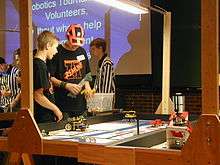
When the official competition convenes, each team brings their robot to compete on an official challenge mat identical to their own. Two members of the team are allowed at the board during a match; however, they can switch out if needed. In the case of a serious problem, such as the entire robot breaking down, the entire team is allowed at the board for as long as the problem persists. Members are not permitted to bring additional robots or board items from other practice tables to the board during competition.
The robot starts in an area marked as 'base', a white area in the corner or to one side of the table. In base, two team members are allowed to touch the robot and start program. If the team touches the robot while it is outside of base (an 'interruption'), the referee will issue a penalty, resulting in a 5-point deduction. These are stationary LEGO models that negate the final score if they remain until the end, providing an incentive to not interrupt the robot. The robot is not required to return to base; some teams have completed all their missions without returning to base during the time allowed to complete the missions. In fact, in the 2008–09,[6] 2009-10,[7] 2011-2012, and 2012-13 challenges, points were awarded if the robot was in one of two specified areas, not including base, at the end of the two and a half minute match.
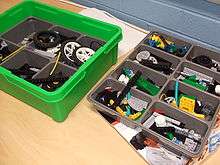
FIRST LEGO League teams use LEGO Mindstorms[8] kits to construct their robots. The robots are programmed using one of the block-based programming environments: the official EV3 software, the official NXT-G software (now outdated), or Robolab. All these are built around Labview.
Events
Teams in different parts of the world have different times allotted to complete the construction of the robot, due to the varying date of qualifying tournaments but must have a minimum of 8 weeks from "Global Challenge Release" (the date, usually in August, by which the details of the missions and research project become available to the public). They go on to compete in FIRST LEGO League tournaments, similar to the FIRST Robotics Competition regionals. In the 2006–07 season, nearly 90,000 students on 8,846 teams[9] from around the world competed. The initial levels of competition are managed by an Affiliate Partner Organization (commonly affiliated Universities), who are led by an Affiliate or Operational Partner Representative ("The Partner"). The Partner has complete control over all official tournaments in their region. Region boundaries are set by FIRST. Some States represent an entire region while others, like Central Florida, represent a mix of Counties within the State.[10] Most Partners have a two-tier system; teams first go to a "Qualifier" and if they meet certain criteria and perform well in all 3 judged areas, they can receive a bid to advance to the next level of competition, which is most often a Regional-Level event. Certain territories have 3-tiers and may also employ a State Championship.[11]
The largest single-day regional qualifying tournament is hosted by First State Robotics and First State FIRST LEGO League in Wilmington, Delaware. Taking place every January, this event holds FIRST LEGO League Jr. (FLL Jr.; grades K-3), FIRST LEGO League (FLL; grades 4–8), FIRST Tech Challenge (FTC; grades 9–12), FIRST Robotics Competition (FRC; grades 9–12), and robot sumo competitions under one roof at the University of Delaware's Bob Carpenter Center. Teams from Eastern Pennsylvania, Southern New Jersey, Delaware, and Maryland (among other regions) attend this tournament to make it the largest single-day FIRST event in the world.[12]
The only competition run by FIRST is the FIRST Championship[13] In 2007, 96 teams competed in the FIRST LEGO League World Festival in Atlanta, Georgia on April 27–30.[14] The 2007–08 Power Puzzle FIRST LEGO League World Festival and the 2008–09 FIRST LEGO League World Festival on Climate Connections were held again in the Georgia Dome and Georgia World Congress Center. Starting with the 2010–11, FIRST LEGO League World Festival is held at the Edward Jones Dome and America's Center in St. Louis. In 2016, FIRST announced that they were expanding the FIRST Championship to two back-to-back events. Through 2020, these events will be held first in Houston, Texas at the George R. Brown Convention Center and the following week in Detroit, Michigan at the Cobo Center.[15][16]
Additionally, the Champion's Award winners from each state/provincial tournament may participate in one of the Open Championships which are organized by FIRST LEGO League Partners.
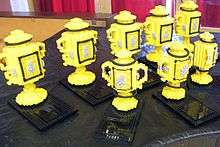
As such, teams are normally allowed to win only one core (judged) award. Teams can win an additional award based on their robot's performance during the robot game competition portion of the tournament.[17]
Competition themes
The challenges for FIRST LEGO League are annually themed based on a real world problem:
| Year | Theme | Number of participants | Number of teams[18] | Summary of Challenge Theme[19] |
|---|---|---|---|---|
| 1999 | First Contact[20] | 9,500 | 960 | It focused around a group of astronauts stranded in a space station; missions included pulling a lever to allow the astronauts into a chamber and delivering oxygen (foam balls) to different sections of the playing field. |
| 2000 | Volcanic Panic[21] | 15,000 | 1,540 | In this challenge, robots had to complete challenges prior to the eruption of a volcano,[22] such as rescuing a stranded scientist, barricading a village from lava rocks, deploying a gas sensor, and retrieving crates of samples, among other volcano-related tasks. |
| 2001 | Arctic Impact[23] | 18,500 | 1,902 | Robots had to complete tasks on an Arctic themed board such as retrieving medicine barrels, and rescuing minifigure scientists from polar bears. |
| 2002 | City Sights | 27,009 | 3,001 | Robots completed tasks such as clearing rocks off a soccer field, harvesting and delivering food loops, collecting toxic barrels, activating a windmill, and other city-related tasks.[24] |
| 2003 | Mission Mars | 42,000 | 4,331 | Inspired by the year's Mars Rover mission, competing teams had to design and construct robots to solve a number of problems like removing rocks from a 'solar panel' to ensure a Mars base energy supply, collect 'soil/rock samples' from the Martian desert landscape, etc. |
| 2004 | No Limits | 50,000 | 5,859 | Centered around various robotic assistant systems for disabled persons, robots demonstrate how the systems are (hopefully) able to solve the given problems in a satisfying way.[25] |
| 2005 | Ocean Odyssey | 60,000 | 7,501 | Involved marine-themed tasks such as mapping a sunken ship, deploying a research submarine, and cleaning up a shipping spill. |
| 2006 | Nano Quest | 90,000 | 8,847 | The challenge is developing anything using nanotechnology[26] that improves or makes life easier from medicine to computers to the environment. |
| 2007 | Power Puzzle | 109,410 | 10,941 | The challenge is on alternative energy and features tasks such as moving power lines, fuel sources and planting trees. |
| 2008 | Climate Connections | 13,705 | The challenge focuses on the Earth's past, present, and future climate. Students must research a climate problem occurring in their area, find a solution, then share it. They also have to research another area which has the same problem as their area. Featured moving balls, bicycles, computers, setting up levees, etc.[27][28] | |
| 2009 | Smart Move[29] | 14,725 | The challenge centers around efficient transportation[30] and teams are to solve a particular problem with the mode of transportation that they have chosen. The robot game includes activating access markers, collecting loops, toggling a lever to move a truck, avoid warning beacons, parking at one of two specified locations, etc. | |
| 2010 | Body Forward[31] | 16,762 | Explore the cutting-edge world of biomedical engineering to discover innovative ways to repair injuries, overcome genetic predispositions, and maximize the body's potential, with the intended purpose of leading happier and healthier lives. The robot game includes moving bionic eyes to the upper body, separating red and white blood cells, opening a door, and more. | |
| 2011 | Food Factor | 204,000[32] | 18,323 | Improving the quality of food by finding ways to prevent food contamination.[33] The missions include removing bacteria, delivering food, and refrigeration. |
| 2012 | Senior Solutions | 20,430[34] | Improve and maintain the quality of life of senior citizens | |
| 2013 | Nature's Fury[35] | 23,748 | Explore the awe-inspiring storms, quakes, waves and more that we call natural disasters. Teams will discover what can be done when intense natural events meet the places people live, work, and play. | |
| 2014 | World Class - Learning Unleashed[36] | 26,044 | Redesign how we gather knowledge and skills in the 21st century. This includes learning any kind of skill at any age. | |
| 2015 | Trash Trek[37] | "233,000+"[38] | 29,034[39] | Make less trash or improve the way people handle the trash we make |
| 2016 | Animal Allies[40] | "255,000+"[41] | 31,079 | It's all about helping our furry, feathered, and finned friends. Improve the way that people and animals interact. What might become possible when we learn to help each other? |
| 2017 | Hydro Dynamics[42] | 35,501 (projected) | On your mark, get set, flow! Learn all about water – how we find, transport, use, or dispose of it. This year's challenge focuses on missions related to water, such as deploying a water pump, and turning a faucet.[43] | |
| 2018 | Into Orbit[44] | The 2018/2019 FIRST® LEGO® League season will transport your team into space, where you’ll explore, challenge, and innovate in the vast expanse of space. |
Recent developments
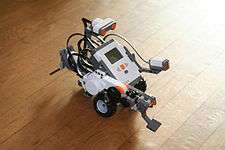

The original robotics kit used by FIRST LEGO League was the RCX Mindstorms kit, which LEGO no longer sells to the general public. In August 2006, LEGO released a new Mindstorms kit called the NXT. In 2006 and 2007, teams using the RCX could earn "fairness bonus" points based on the fact that the RCX was less technologically advanced.[45] However, the "fairness bonus" was discontinued for the 2008-09 season because tournament experience proved that the RCX teams were competitive and did not need it. In 2013, the NXT series kit was superseded by the EV3 series and the competition guidelines were updated to allow both EV3 and NXT-based robots to compete.
Global Innovation Award
Officially registered teams can also be nominated by their region for the Global Innovation Award, where they could win a grant to make their innovative solution to the annual challenge theme's problem a reality.[46] As of the Animal Allies Season, the First Place team wins $20,000 and two other Finalists each win $5,000. The money can be used to further the team's ideas or to continue in FIRST programs. All three finalist teams also receive a LEGO Mindstorms Education EV3 Robot Set. All submissions are reviewed by a panel of judges consisting of experts from engineering and industrial fields as well as experts in the challenge theme for that year. Teams are judged on problem identification, innovation, implementation, and effective use of STEM principles. From all of the teams nominated by every FIRST LEGO League region, twenty teams are selected as semi-finalists and are invited to attend the Global Innovation Award Celebration in Washington, D.C. At the D.C. event, the first place and other finalist teams winning the cash prizes are announced.[47]
Levels of Competition
Teams compete to advance levels. First, teams go to qualifying tournament. A handful of winners are then selected based on their performance at the qualifying round are then invited to the state championships. Awards are given at both rounds. Winners from the state competition (usually 1-2 teams) are then invited to the World Festival. The North American championship, with teams from Europe, Asia, and North America, also feeds teams to the World Championship. The World Festival displays the Champion's Award-winning teams from across the globe (See above).[48]
See also
Notes
- 1 2 "Welcome to FIRST LEGO League". FIRST LEGO League. Archived from the original on 12 March 2009. Retrieved 15 April 2009.
- 1 2 3 4 "Start a Team". FIRST. Retrieved 19 June 2011.
- ↑ "What is FLL?". Archived from the original on 22 September 2016. Retrieved 24 September 2016.
- ↑ "Students use robots during "Mission Mars" at LEGO League tournament". FIRST. Archived from the original on 27 September 2011. Retrieved 9 August 2011.
- ↑ "FIRST LEGO League Judging Rubrics" (PDF). Retrieved August 7, 2017.
- ↑ "Climate Connections: Mission, Field Setup, Rules, and Project" (PDF). FIRST. Archived from the original (PDF) on 8 December 2015. Retrieved 7 August 2011.
- ↑ "Smart Move: Missions, Game Q&A, Field Setup, Project" (PDF). FIRST. Retrieved 7 August 2011.
- ↑ "Welcome to FLL". FIRST. Retrieved 18 June 2011.
- ↑ "The Challenge". FIRST. Retrieved 4 June 2012.
- ↑ "Our Mission". Central Florida Robotics. Retrieved 2017-08-07.
- ↑ "FIRST LEGO League Coaches' Handbook" (PDF). Retrieved August 7, 2017.
- ↑ "First State FIRST LEGO League". Archived from the original on 31 December 2008. Retrieved 22 November 2008.
- ↑ "World Festival". Archived from the original on 13 April 2009. Retrieved 15 April 2009.
- ↑ "NanoQuestWorldFestivalTeamRoster5.pdf" (PDF). Archived from the original (PDF) on 22 April 2007. Retrieved 16 September 2007.
- ↑ "Welcome | FIRST Championship". www.firstchampionship.org. Retrieved 2017-08-07.
- ↑ Official FIRST (2016-02-16), FIRST Championship - 2017 and beyond, retrieved 2017-08-07
- ↑ "FLL Awards". Retrieved 3 October 2009.
- ↑ "FLL At-a-Glance | FIRST LEGO League" (PDF). www.firstlegoleague.org. Retrieved 2017-12-07.
- ↑ "Past Challenges | FIRST LEGO League". www.firstlegoleague.org. Retrieved 2017-08-08.
- ↑ "FIRST LEGO League / 1999". Archived from the original on 27 September 2007. Retrieved 16 September 2007.
- ↑ "FIRST LEGO League / 2000". Archived from the original on 7 August 2007. Retrieved 16 September 2007.
- ↑ "Lego Robots at TTU to Save Planet From Volcanoes". Archived from the original on 27 September 2011. Retrieved 9 August 2011.
- ↑ "FIRST LEGO League / 2001". Archived from the original on 27 September 2007. Retrieved 16 September 2007.
- ↑ "FIRST LEGO League / 2002". Archived from the original on 10 June 2007. Retrieved 16 September 2007.
- ↑ "FIRST LEGO League / 2004". Archived from the original on 8 August 2007. Retrieved 16 September 2007.
- ↑ "Watch FIRST Lego League Tournament in Memorial Gym on Saturday". Archived from the original on 27 September 2011. Retrieved 9 August 2011.
- ↑ "The Project". Archived from the original on 21 March 2009. Retrieved 15 April 2009.
- ↑ "Welcome to Climate Connections!". Archived from the original on 21 March 2009. Retrieved 15 April 2009.
- ↑ "Transforming Transportation – Launched September 2009". Retrieved 2009-10-03.
- ↑ "Children to make 'Smart Move' at LEGO tournament Saturday at Tennessee Tech". Archived from the original on 27 September 2011. Retrieved 9 August 2011.
- ↑ "2010 Season Topic". Archived from the original on 17 March 2009. Retrieved 15 April 2009.
- ↑ Rosen, J. H.; Hendricks, C. C.; Robinson III, N. F. (25 June 2013). "FIRST LEGO League Participation: Perceptions of Minority Student Participants and their FLL Coaches". Proceedings of the American Society for Engineering Education (ASEE) Conference, Atlanta. ASEE. p. 2.
- ↑ Rossant, Juliette (26 June 2011). "Join the FIRST LEGO League's Food Factor Challenge!". Super Chef.
- ↑ "FLL Growth" (PDF). FIRST. Archived from the original (PDF) on 9 September 2015. Retrieved 9 September 2015.
- ↑ "2013 Nature's Fury Challenge". FIRST. Archived from the original on 21 November 2012. Retrieved 4 June 2012.
- ↑ "2014 FLL World Class Challenge". FIRST. Archived from the original on 2 December 2013.
- ↑ "2015 TRASH TREK Challenge". FIRST Lego League. FIRST.
- ↑ "FIRST LEGO League -". www.firstlegoleague.org.
- ↑ "FIRST® 2016 Annual Report". Retrieved 2017-08-08.
- ↑ "2016 ANIMAL ALLIES Challenge | FIRST LEGO League". www.firstlegoleague.org. Archived from the original on 6 February 2016. Retrieved 6 February 2016.
- ↑ "At A Glance". FIRST. 2015-08-21. Retrieved 2017-09-20.
- ↑ "Challenge | FIRST LEGO League". firstlegoleague.org. Retrieved 2017-08-07.
- ↑ "Challenge | FIRST LEGO League". firstlegoleague.org. Retrieved 2017-08-07.
- ↑ "Challenge | FIRST LEGO League". firstlegoleague.org. Retrieved 2018-08-09.
- ↑ "2007 Power Puzzle Challenge: Missions, Rules, Field Set Up, Project" (PDF). Archived from the original (PDF) on 6 June 2011. Retrieved 6 December 2007.
- ↑ "Global Innovation". FIRST. 2015-08-06. Retrieved 2017-08-07.
- ↑ "Global Innovation Guidelines". FIRST. 2016-09-26. Retrieved 2017-08-07.
- ↑ "Events | FIRST LEGO League". www.firstlegoleague.org. Retrieved 2017-12-28.
External links
| Wikimedia Commons has media related to FIRST Lego League. |

